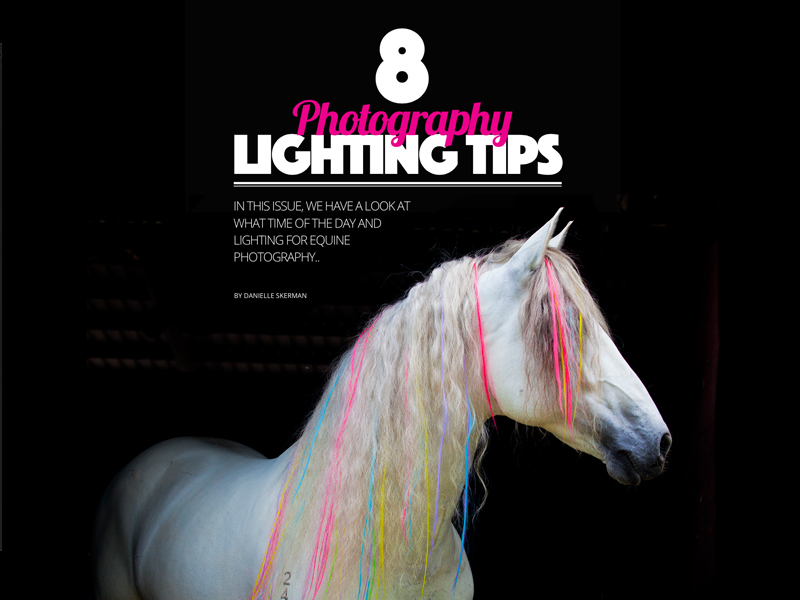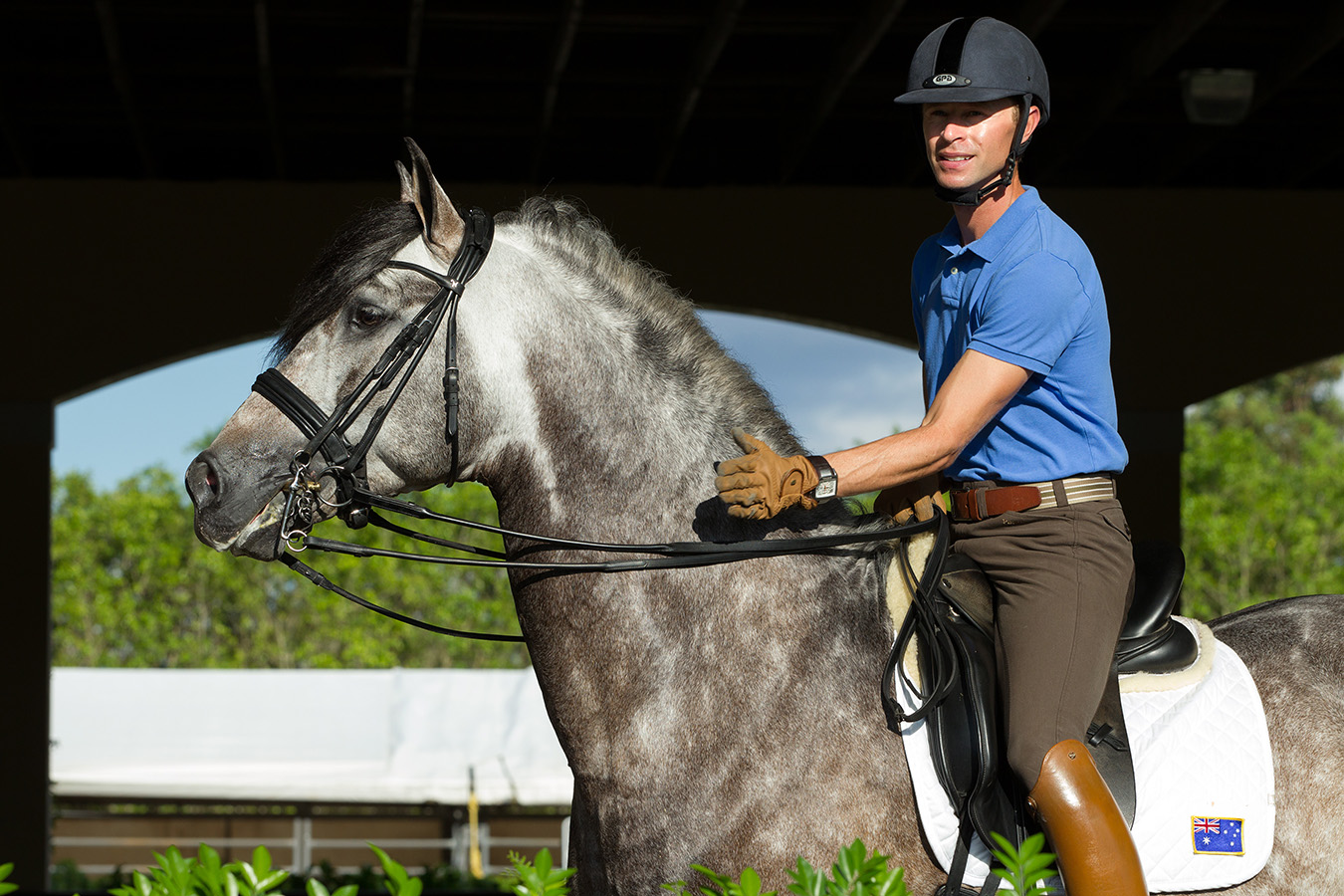
8 Photography Lighting Tips

8 Photography lighting tips by Danielle Skerman
1. ACTION SHOTS
To get a good action shot, whether it be free running or under saddle good bright sidelight is always best. Now when I say side light, what I mean is mid-morning or mid-afternoon when the sun is giving you full light on the side of the horse. Generally, I say to avoid shooting during the middle of the day when the light is directly above. The reason is that no matter what side of the horse you photograph from you’ll always get shadows. With the sun coming from above, it’ll shadow downwards. Look at the horse and see if you can get a clean side of light on the horse, if so then you’re good to go for action shots! To help you get an idea, next time you’re outside hold your hand up move it around and see where it shadows. When you can get the palm of your hand in full light then that’s a great time to whip the camera out for those action shots. Keep the sun to your back and watch out for your shadow.
2. SALE PHOTOS
For sale photos, you’ll generally want to show the horses confirmation and condition along of course with its ability. The best lighting for this is again, mid morning or mid afternoon. In generally you’ll want to avoid late afternoon light as it is warm/yellow light- ing. Can make a black look very bleached out or make a grey look dirty. Morning light is best for coat colour as it is cool lighting and more blue and that’ll give you a clean, crisp lighting and that’ll give you a more accurate coat colour.
3. STUDIO PORTRAIT TYPE PHOTOS
Have you ever seen a gorgeous shot with the black background and wondered how they do it? Or thought it was done with special studio lights and backdrops. Well, sometimes it could be, but more often then not and there is a bit of a trick to it. If you have a stable or shelter that gets a good shadow is all you need. Put the horse’s body in the shadow park and the head and shoulders in the sun. Because of the bright light, the camera can not expose for both light and dark, so if you focus on the light, the camera will expose for the light, thus making the shadow area dark. If you’re handy with photo editing skills, you can work the image more giving you that real portrait feel. Best time of day for this is again mid-morning or afternoon.
4. SWEET AFTERNOON LIGHT
If you are wanting to get artistic and want to get that sun rays streaming around your horse, then the best light is very early morning – just after sunrise or late afternoon. You have about a 30-45 minute window of this sort of light, and in the best lighting only lasts about 10minutes. So there isn’t time to mess around too much. What you want is the light (sun) to be very low to the horizon and in a spot that you can place it behind your horse/ subject. If you can place the sun off to the side to come from the corners of the image will be the best for the sun rays. To get the circle lens flare, you need to have some part of the sun going directly into the camera. You have to be careful that it’s not too early in the afternoon as the sun will be too bright and you will get a white washed out photo. This is best achieved in that last 10 minutes before the sun disappears over the horizon. I would recommend to always shoot into the light to achieve this effect.
5. PORTRAIT LIGHTING
If you want to get that nice portrait shot, then that magic time of day again is the best, mid morning and mid afternoon. You can do so earlier or later, however, if you do go later in the afternoon, again watch the colour of the light on your horse’s coat. To make sure you get the detail on the horse you need to keep the sun to your back. If you shoot with the sun behind the horse, then you run the risk of silhouetting your horse, and thus loosing image detail.
6. FLASH LIGHTING – WHEN TO USE IT
Using the flash is typically used for creative photography. I say that because horses and flashes predominately don’t mix. And 98% of the time that is true. But to every rule, there is the exception. As the light drops and you’re getting creative, you can pop some flash in to give you a bit more to your image. Or if you’re working with the sun behind the subject/horse you can pop some fill flash (half flash power), which will give you more detail in the shadow areas. However, things to keep an eye out for is the flash reflection in the horse’s eye; this reflective effect can make your horse look a little scary. This can be hard to avoid, however, if you are skilled in photo editing, it can be removed in your post editing work. Another thing to be mindful on is not to use a too powerful flash as you can get the typical flash look of all lit up in the grass in front and the back is pitch night black! Best used in late after-noon light where there is still some decent light around to help keep some detail in the surroundings.

7. IN THE SHADE
Traditionally, we always like to photograph horses in the full sun light directly on their side. However if picking the time of day just isn’t much of a choice (or you wish to be creative), then if you can put the horse in the shade. This will avoid horrible patchy shadowing from the sun. By doing this, you can get more even lighting. Keep an eye on your background when doing this. If you just put them under a tree and shoot with the background super bright, you’ll blow out the background, and it will become a very bright white light. If this is unavoidable, then try to zoom in as much as possible and cut out as much background as you can. Another tip is if you have the big car shades or rug you can hold up to create your own shading.
8. OVERCAST DAYS
All is not lost on overcast days. If you have a grey horse then even better as a sunny day really doesn’t show coat shine. Just like human photography, overcast days are brilliant for portraiture. This is a nice soft light that is free from shadows and generally speaking, is a cleaner in colour which enables a nice coat colour and no nasty shadows on people’s face. However, may lack the sheen and reflection full sunlight will give. If you want to get a little shine on the coat you can use video lighting, torch or a reflector to the horse’s coat. Please note, that if you are shooting on an overcast day you will get an over exposed white sky, this is unavoidable if a white sky is in the shot. Can be very moody looking if its grey tho!







